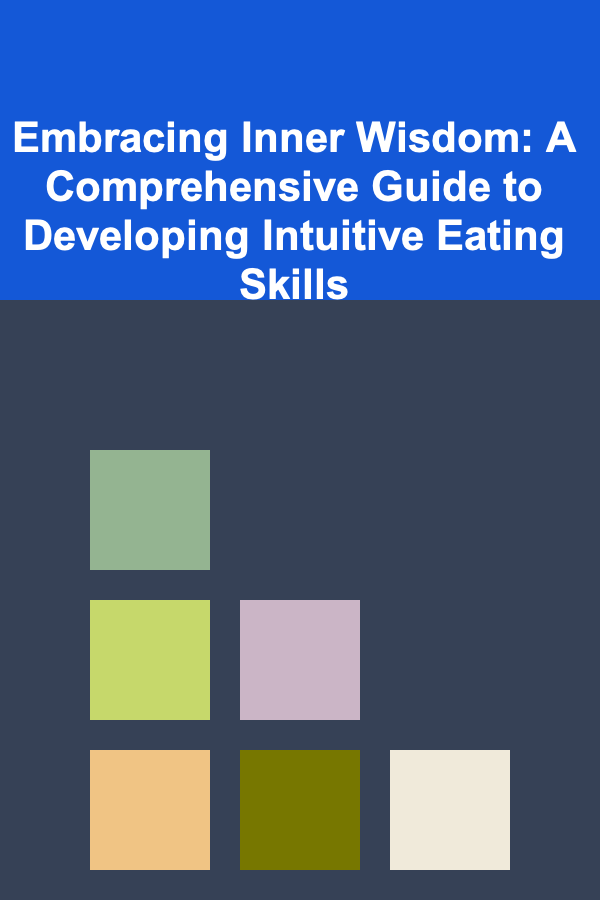
Embracing Inner Wisdom: A Comprehensive Guide to Developing Intuitive Eating Skills
ebook include PDF & Audio bundle (Micro Guide)
$12.99$10.99
Limited Time Offer! Order within the next:

In a world saturated with diet culture, quick fixes, and conflicting nutritional advice, finding a sustainable and healthy relationship with food can feel like an insurmountable challenge. From calorie counting to restrictive meal plans, countless individuals embark on a relentless pursuit of weight loss or "optimal health," often finding themselves trapped in a cycle of deprivation, guilt, and rebound weight gain. This perpetual struggle not only impacts physical health but significantly erodes mental and emotional well-being, fostering a deep distrust in one's own body.
Enter Intuitive Eating: a revolutionary, evidence-based approach developed by dietitians Evelyn Tribole and Elyse Resch. Far from being another diet, Intuitive Eating is a self-care framework that helps individuals heal their relationship with food, mind, and body by reconnecting with their innate body wisdom. It's about tuning into your internal hunger, fullness, and satisfaction cues, and learning to trust your body to guide your eating choices. This comprehensive guide will delve deep into the philosophy, principles, and practical steps for cultivating intuitive eating skills, empowering you to reclaim your body's wisdom and foster a lifetime of mindful, joyful nourishment.
What is Intuitive Eating? Unpacking the Core Concept
At its heart, Intuitive Eating is a dynamic, non-diet approach to eating that rejects external rules and instead encourages individuals to listen to their body's internal signals. It's a process of returning to a natural state of eating, much like how infants instinctively know when to eat, how much, and when to stop. Over time, diet culture, emotional eating patterns, and societal pressures can disconnect us from these innate signals. Intuitive Eating aims to bridge that gap.
It's crucial to understand what Intuitive Eating is not:
- It is not a diet: There are no food rules, no forbidden foods, no calorie counting, and no emphasis on weight loss. While weight stabilization or changes may occur as a byproduct of a healthier relationship with food, it is never the primary goal.
- It is not a free-for-all: Some misinterpret Intuitive Eating as an excuse to eat whatever you want, whenever you want, without consequences. While unconditional permission to eat is a core principle, it's balanced with listening to your body's physical needs and aiming for gentle nutrition and satisfaction.
- It is not a quick fix: Developing intuitive eating skills is a journey of self-discovery and unlearning. It requires patience, persistence, and often, professional support.
Instead, Intuitive Eating is a journey towards body respect, self-compassion, and developing a deep, trusting relationship with your body's signals and needs. It's about finding peace with food and fostering well-being that transcends the number on a scale.
The Transformative Power of Intuitive Eating: Benefits Beyond the Plate
Embracing intuitive eating extends far beyond just how you eat. It cultivates a profound shift in your overall relationship with yourself, leading to a myriad of psychological and physical benefits:
- Improved Body Image and Self-Acceptance: By shifting focus from external appearance to internal cues and body respect, individuals often experience a greater appreciation for their bodies, regardless of size.
- Reduced Disordered Eating Thoughts and Behaviors: Breaking free from the diet cycle significantly diminishes obsessive thoughts about food, bingeing, restricting, and compensatory behaviors.
- Enhanced Self-Care and Emotional Well-being: Learning to cope with emotions without relying on food fosters healthier emotional regulation and reduces guilt and shame.
- Greater Food Freedom and Enjoyment: All foods are allowed, leading to a less restrictive and more joyful experience with eating. The fear of "bad" foods dissipates.
- Sustainable Health Outcomes: Unlike diets that are often temporary, intuitive eating promotes lifelong healthy habits that are internally driven and sustainable.
- Increased Self-Efficacy and Trust: As you learn to trust your body's wisdom, you build confidence in your ability to make choices that truly serve your well-being.
- Lower Risk of Weight Cycling: By moving away from restrictive diets, the yo-yo effect on weight is often mitigated, leading to more stable and healthy body weight.
- Better Psychological Health Markers: Studies have linked intuitive eating with lower rates of depression, anxiety, and higher self-esteem.
These benefits highlight that Intuitive Eating is not just about nutrition; it's a holistic pathway to a more peaceful and fulfilling life.
The 10 Core Principles of Intuitive Eating: A Framework for Self-Nourishment
Tribole and Resch outline ten foundational principles that guide the journey of becoming an intuitive eater. These principles are interconnected and work synergistically to help you reconnect with your inner wisdom. They are not rules to be followed perfectly, but rather guideposts for exploration and learning.
1. Reject the Diet Mentality
This is the cornerstone. Diet culture has deeply ingrained beliefs that we need external control over our eating. This principle calls for a conscious and forceful rejection of the notion that diets work, that there's a "perfect" way to eat, or that you need to be "fixed." It involves recognizing and discarding diet books, magazines, and social media accounts that promote restrictive eating or unrealistic body ideals. It's about understanding that dieting often sets you up for failure, leading to a cycle of deprivation, craving, and eventual overeating.
Practical step: Throw out diet books, unfollow diet-related social media, challenge your internal "food rules."
2. Honor Your Hunger
Your body has an innate biological drive to eat. Learning to honor this fundamental signal is crucial. This principle means recognizing the physical sensations of hunger -- from a gentle stomach rumble to a more intense gnawing -- and responding to them promptly and adequately. It's about providing your body with food when it needs it, rather than waiting until you're ravenous, which can often lead to overeating or poor food choices. It also involves distinguishing physical hunger from emotional hunger.
Practical step: Tune into hunger cues before eating. Use a hunger scale (1-10) to assess your level of hunger.
3. Make Peace with Food
This principle involves giving yourself unconditional permission to eat all foods. No "good" or "bad" foods, no "allowed" or "forbidden" foods. When certain foods are deemed off-limits, they often become more desirable, leading to intense cravings, feelings of deprivation, and eventually, a powerful urge to binge. By making peace with food, you remove the psychological power that restrictive rules give to certain foods, allowing you to integrate them into a balanced eating pattern without guilt or shame.
Practical step: Challenge a "forbidden" food. Eat it mindfully and notice your body's response without judgment.
4. Challenge the Food Police
The "Food Police" are those internalized voices that judge your eating choices, using terms like "you're so bad for eating that," or "you shouldn't have had seconds." These voices are often a remnant of diet culture. This principle encourages you to identify and challenge these critical thoughts, replacing them with self-compassionate and neutral observations. It's about dismantling the internal critic that perpetuates guilt and shame around food.
Practical step: When a "Food Police" thought arises, acknowledge it, then reframe it with a neutral or compassionate statement.
5. Discover the Satisfaction Factor
Eating is not just about physical nourishment; it's also about pleasure and satisfaction. This principle encourages you to find true enjoyment in your eating experience. This means choosing foods you genuinely desire, eating in pleasant environments, savoring flavors, textures, and aromas, and stopping when you feel comfortably satisfied, not just full. When you truly enjoy your food, you often find that you need less of it to feel content.
Practical step: Eat slowly, put down your fork between bites, engage all your senses. Ask yourself: "Is this truly satisfying?"
6. Feel Your Fullness
Just as important as honoring hunger is recognizing and respecting your body's cues of fullness. This principle involves pausing during a meal to check in with your body's signals of satiety. Are you feeling comfortably full, pleasantly satisfied, or overly stuffed? It's about listening to the messages your body sends when it's had enough, allowing you to stop eating when you're no longer hungry, rather than when the plate is empty or you feel uncomfortable.
Practical step: Take a break midway through a meal. Assess your fullness level. Ask yourself: "Am I still hungry?"
7. Cope with Your Emotions with Kindness
Food is often used as a coping mechanism for emotions like stress, sadness, boredom, or anger. This principle acknowledges that emotional eating is a common and normal human behavior, but encourages you to find alternative, non-food-related ways to cope with your feelings. It's about developing emotional literacy and building a repertoire of self-care strategies that truly address your emotional needs, rather than temporarily suppressing them with food.
Practical step: Identify emotional eating triggers. Explore non-food coping mechanisms like journaling, talking to a friend, exercise, or meditation.
8. Respect Your Body
This principle is about accepting and respecting your body's natural size and shape, regardless of whether it aligns with societal ideals. It's about moving away from body dissatisfaction and learning to appreciate your body for what it can do, rather than constantly striving to change it. This is a foundational step, as it's difficult to be an intuitive eater if you're constantly fighting against your own body and its inherent set point.
Practical step: Dress comfortably. Practice body neutrality by focusing on what your body does for you, not how it looks. Challenge negative self-talk about your body.
9. Movement---Feel the Difference
This principle encourages you to engage in physical activity that you genuinely enjoy, focusing on how it makes you feel rather than on burning calories or achieving a certain body size. It's about joyful movement, not punishment. This shift in perspective helps foster a sustainable and positive relationship with physical activity, promoting overall well-being and vitality.
Practical step: Explore different forms of movement. Choose activities that feel good and energize you, not those you feel you "should" do.
10. Honor Your Health---Gentle Nutrition
This is the final principle, integrated once the other nine have been explored. It acknowledges that nutrition plays a role in health but emphasizes a flexible and sustainable approach. It's about making food choices that honor your health and taste buds while not striving for perfection. It encourages seeking pleasure and variety in food, without rigid rules or an "all-or-nothing" mentality. It's about balancing nourishment with satisfaction and enjoyment.
Practical step: Focus on adding nourishing foods rather than restricting others. Pay attention to how different foods make you feel (energy levels, digestion).
Developing Intuitive Eating Skills: A Practical Journey
Transitioning to intuitive eating is a process of unlearning and relearning. It's not a linear path, and there will be ups and downs. Here's a practical guide to help you cultivate these essential skills:
Phase 1: Laying the Foundation -- Reconnecting with Your Body
Step 1: Self-Assessment and Awareness
- Reflect on Your Eating History: How many diets have you tried? What were the outcomes? What are your current beliefs about food and your body? Understanding your past can illuminate patterns to break.
- Keep a Non-Judgmental Food and Feeling Journal: Not for tracking calories, but for noting what you eat, when, where, with whom, and importantly, how you feel (emotionally and physically) before, during, and after eating. This helps identify triggers and patterns.
- Identify Your Current Food Rules: Make a list of all the foods you "shouldn't" eat or rules you follow (e.g., "no carbs after 6 PM," "must eat breakfast"). This is the first step to rejecting them.
Step 2: Ditching the Scales and Diet Books
- Remove External Measures: Put away your bathroom scale. Unsubscribe from diet newsletters, unfollow diet influencers, and get rid of diet books. These external metrics and messages actively interfere with your ability to listen to internal cues.
- Commit to No More Dieting: Make a conscious decision to step off the diet roller coaster. This commitment is empowering and frees up mental space.
Step 3: Reconnecting with Hunger Cues
- Practice the Hunger Scale: Before eating, rate your hunger on a scale of 1 to 10 (1 = ravenous, 5 = neutral, 10 = painfully full). Aim to eat when you are around a 3 or 4 -- gently hungry, but not starving.
- Check-in Regularly: Throughout the day, ask yourself, "Am I hungry? What kind of hunger is this (physical or emotional)?"
- Observe Physical Sensations: Pay attention to stomach rumbling, lightheadedness, fatigue, irritability (often called "hangry"). Learn your unique hunger signals.
Step 4: Recognizing Fullness Cues
- Practice the Fullness Scale: During and after eating, assess your fullness on a scale of 1 to 10 (1 = empty, 5 = comfortably satisfied, 10 = painfully stuffed). Aim to stop eating around a 6 or 7 -- pleasantly satisfied, not overstuffed.
- Mid-Meal Check-in: Halfway through your meal, pause. Put your fork down. Take a breath. Ask yourself: "How am I feeling? Am I still hungry? Am I starting to feel satisfied?"
- Slow Down Your Eating: Eating too quickly makes it difficult to register fullness cues. Try to eat slowly, chew thoroughly, and savor each bite.
Phase 2: Cultivating Mindfulness and Self-Compassion
Step 5: Mindful Eating Practices
- Engage All Your Senses: Before you eat, look at your food, notice its colors, shapes, and textures. Smell its aroma. As you eat, pay attention to the taste, temperature, and mouthfeel.
- Minimize Distractions: Turn off the TV, put away your phone, and step away from your computer during meals. Eating mindfully in a calm environment enhances satisfaction and awareness.
- Savor Each Bite: Really focus on the experience of eating. This can increase satisfaction and reduce the desire for more food than your body needs.
Step 6: Addressing Emotional Eating
- Identify Emotional Triggers: When you feel the urge to eat when not physically hungry, pause. What emotion are you feeling? (Stress, boredom, loneliness, anger, anxiety?).
- Develop a "Tool Kit" of Non-Food Coping Mechanisms: Brainstorm alternative ways to address your emotions:
- For stress: Deep breathing, meditation, a warm bath, listening to music.
- For boredom: Call a friend, read a book, go for a walk, work on a hobby.
- For sadness/loneliness: Talk to someone, watch a comforting movie, write in a journal.
- Practice the "Pause and Plan": Before reaching for food emotionally, pause, identify the emotion, and then choose a coping mechanism that truly addresses the feeling.
Step 7: Practicing Self-Compassion
- Acknowledge Setbacks Without Judgment: You will have days where you revert to old patterns. This is normal. Instead of self-criticism, offer yourself kindness and understanding. "It's okay, I'm learning, what can I learn from this?"
- Challenge the Inner Critic: When the "Food Police" or your inner critic speaks up, consciously reframe negative thoughts with neutral or compassionate ones.
- Treat Yourself Like a Good Friend: Ask yourself, "What would I say to a friend going through this?" Then offer yourself that same understanding and support.
Phase 3: Navigating Food Choices and Movement
Step 8: Exploring Food Preferences and Satisfaction
- Unconditional Permission to Eat: Start by allowing yourself to eat foods you previously restricted. This is crucial for breaking the "forbidden fruit" mentality. You might find you don't even crave them as much once they're not off-limits.
- Experiment with Variety: Try different foods and notice how they make your body feel. Which foods provide sustained energy? Which lead to a crash? Which are truly satisfying?
- Balance and Pleasure: Remember that satisfaction comes from a balance of taste, texture, and physical comfort. Sometimes a salad is satisfying, other times it's a burger. Both are valid.
Step 9: Embracing All Foods (Food Neutrality)
- Remove Moral Judgment: Stop labeling foods as "good" or "bad." Food is just food. This helps to reduce guilt and shame.
- Exposure and Habituation: If you have a history of bingeing on certain foods, having them readily available and knowing you can eat them anytime can actually reduce their allure. The novelty and desperation wear off.
Step 10: Finding Joyful Movement
- Shift Your Mindset: Instead of viewing exercise as punishment or a way to burn calories, focus on how movement makes your body feel. Energy, strength, reduced stress, improved mood.
- Explore Different Activities: Try various forms of movement -- dancing, walking in nature, swimming, yoga, cycling, team sports. Find what genuinely brings you joy and makes you feel good.
- Listen to Your Body's Needs: Some days your body might crave intense activity, others gentle stretching or rest. Honor these changing needs.
Step 11: Integrating Gentle Nutrition
- Post-Diet Phase: This principle comes last because it's difficult to integrate nutrition science effectively until you've healed your relationship with food and your body.
- Focus on Adequacy and Variety: Rather than rigid rules, aim for a wide range of foods that provide essential nutrients. Think about what you can add for health, not what you must restrict.
- Observe Your Body's Response: Notice how different combinations of foods affect your energy, digestion, and mood. For example, you might notice that a meal with protein, fat, and fiber keeps you fuller longer than one high in refined carbohydrates.
- Flexibility is Key: Gentle nutrition means there's always room for flexibility and enjoyment. One meal or day of less-than-optimal eating will not derail your health.
Phase 4: Overcoming Challenges and Seeking Support
Step 12: Anticipating and Addressing Setbacks
- Normalize the Process: Intuitive Eating is not a "perfect" way to eat. There will be days you overeat, undereat, or struggle with emotional eating. These are learning opportunities, not failures.
- Reflect and Learn: When a setback occurs, instead of self-criticism, ask: "What happened? What was I feeling? What can I do differently next time?"
- Recommit to Principles: Gently guide yourself back to honoring your hunger, fullness, and self-compassion.
Step 13: Navigating Social Situations
- Pre-Planning: Before social gatherings, mentally prepare. Decide how you want to approach food without succumbing to external pressures or your old diet rules.
- Setting Boundaries: You don't owe anyone an explanation for your eating choices. "I'm just eating what feels good to me" or "I'm savoring this" are perfectly valid responses.
- Focus on Connection: Remember that social events are about connecting with people, not just food.
Step 14: Seeking Professional Guidance
- Registered Dietitian (RD) specializing in Intuitive Eating: An RD trained in the Intuitive Eating framework can provide personalized guidance, address specific nutritional concerns, and help you navigate the principles.
- Therapist or Counselor: If emotional eating is deeply rooted in trauma, anxiety, depression, or other mental health challenges, a therapist can provide crucial support in processing these underlying issues.
- Support Groups: Connecting with others on a similar journey can provide encouragement, shared experiences, and a sense of community.
The journey to intuitive eating is deeply personal and unfolds at its own pace. It requires immense patience, self-awareness, and a willingness to challenge deeply ingrained beliefs about food, body, and self-worth. It is about trusting your body's innate wisdom, a wisdom that has been overshadowed but never truly lost.
Common Challenges and How to Navigate Them
While the benefits are profound, the path to intuitive eating is not without its hurdles. Understanding common challenges can help you prepare and navigate them effectively.
- Fear of Weight Gain: This is arguably the biggest fear. Many equate intuitive eating with uncontrolled eating and inevitable weight gain. It's vital to acknowledge this fear and understand that intuitive eating often leads to weight stabilization at a body's natural set point, which may or may not be your desired weight. Focusing on internal well-being rather than external size is paramount. Seeking professional guidance can be particularly helpful here.
- "Rebound" Eating: In the initial stages, after years of restriction, you might experience an increased desire for previously forbidden foods. This is normal and part of the habituation process. Give yourself unconditional permission to eat these foods. Over time, their allure diminishes as they lose their "specialness."
- Lack of Immediate Results: Unlike diets that promise rapid (though often unsustainable) weight loss, intuitive eating is a slow, gradual process of healing. Patience is key. Celebrate small victories, like recognizing a hunger cue or challenging a diet thought.
- Social Pressure and Comparison: Family, friends, and social media can perpetuate diet culture, making it hard to stick to your intuitive eating path. Develop polite ways to decline diet talk, change the subject, or limit exposure to triggering content. Remember, your journey is your own.
- Body Image Struggles: Even with a shift in focus, negative body image can persist. Continue practicing body respect, focusing on what your body does for you, and challenging the unrealistic beauty standards perpetuated by society. This is an ongoing process of self-acceptance.
- Confusing Emotional Hunger with Physical Hunger: This is a core challenge. Consistent practice with the hunger/fullness scale and developing alternative coping mechanisms are vital. Be compassionate with yourself when you slip into emotional eating; simply observe and learn.
- The All-or-Nothing Mentality: Years of dieting often instill a perfectionist mindset. Intuitive eating encourages flexibility and nuance. One "un-intuitive" meal doesn't ruin your progress; it's simply a moment to learn from.
The Long-Term Journey: Patience and Persistence
Developing intuitive eating skills is not a destination but a lifelong journey. It's an ongoing dialogue with your body, a continuous process of learning, adapting, and growing. There will be phases where it feels effortless and phases where old patterns resurface. The key is to approach each moment with curiosity, compassion, and a commitment to self-care.
Remember that the goal is not to be a "perfect" intuitive eater, as perfection doesn't exist. The goal is to cultivate a peaceful, flexible, and respectful relationship with food, movement, and your body. This relationship allows you to nourish yourself from a place of wisdom, trust, and self-love, fostering true well-being that lasts a lifetime.
In a world obsessed with control and external validation, Intuitive Eating offers a radical and deeply empowering alternative. It invites you to reclaim your inherent body wisdom, step away from the tyranny of diet culture, and embark on a journey of self-discovery and profound self-care. By diligently applying its ten principles and practicing patience and self-compassion, you can develop the skills to honor your body's signals, make peace with food, and truly savor the experience of nourishment. This journey will not only transform your relationship with eating but also foster a deeper sense of trust, freedom, and well-being in all aspects of your life. Embrace your inner intuitive eater, and discover the peace that comes from truly listening to yourself.

How to Clean Your Home in 30 Minutes or Less
Read More
How to Create a DIY Advent Calendar to Countdown to Christmas
Read More
How to Get Cheap Flights with Layovers
Read More
How to Provide Constructive Feedback on Student Videos
Read More
How to Use Technology in Home and Office Design for Better Client Results
Read More
How To Play Party Board Games for Maximum Fun
Read MoreOther Products

How to Clean Your Home in 30 Minutes or Less
Read More
How to Create a DIY Advent Calendar to Countdown to Christmas
Read More
How to Get Cheap Flights with Layovers
Read More
How to Provide Constructive Feedback on Student Videos
Read More
How to Use Technology in Home and Office Design for Better Client Results
Read More